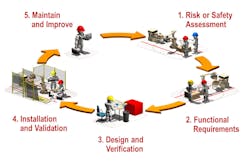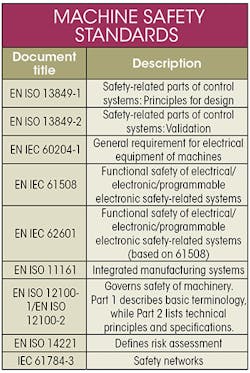9 Safety Tips to Help Navigate the Engineering World of 2018
For several of the major buzz topics floating around the last few years, 2018 may be the year these innovations finally take hold. To wit: Several companies are starting to implement smart automation, sensors, big data analytics, and cloud computing.
However, several of the same problems that have persisted in the past will still plague us in 2018. The labor shortage is ongoing, as are security concerns—especially in the cyber realm. The globalization of several industries will be challenge as many companies will rely on partnerships to succeed.
With the implementation of the Internet of Things, learning how to deal with big data and the best way to analyze said data will be a pressing concern. And lastly, how does one future-proof their systems to handle new innovations as they arise?
To help guide you through these concerns, Rockwell Automation has compiled a list of nine tips to help achieve improvements in safety and productivity.
Improve Your Safety Maturity
Safety maturity is a combination of culture (behavior), compliance (policies and procedures), and use of capital (technologies). Studies show that the top 20% of manufacturers achieve 5 to 7% higher overall equipment effectiveness, 2 to 4% less unscheduled downtime, and less than half the injury rate of average performers. These top companies are not only leading the way but are extending that lead over competitors.
A survey from LNS Research found that 75% of industrial companies have seen operational improvements from the use of advanced safety technology. The leading companies see safety as a key element in their business plans. They use contemporary safety methodologies to achieve such a high standard.
To achieve a high safety maturity, start by assessing your own safety maturity level and see how you compare to some of the companies at the top. Understanding what your performance level is and which areas are in need of improvement is critical to optimizing safety.
Address Safety and Security Together
Cyberthreats will increase as companies increase the connectivity of their operations. The IoT brings more sensing capability and with data analytics a better understanding of one’s systems. However, it also opens the door for more threats as devices are being connected directly to the internet.
Organizations should be reviewing their security risks in relation to their safety risks. By integrating safety and security programs, companies can assess, manage, and mitigate the safety implications of security risks.
Improve Collaboration
Environmental, health, and safety (EHS) programs are responsible for workers safety. However, the EHS programs only directly control the least effective machinery safety methods. Engineering teams focus on technical standards and control the most-effective machinery safety methods. Both groups usually have a hard time working together, which results in reduced safety and productivity.
The key element for safety maturity is collaboration between different groups. According to LNS Research, companies that have high collaboration between operations, engineering, and safety groups experience a 15% lower median incident rate.
Perform Risk Assessments Early
The diagram above from Rockwell Automation highlights its safety cycle from early risk assessment to installation and maintenance.
Many times when we design a product, we worry about its safety toward the end of the design. This is a common practice as many companies build first, test for falls, and then redesign. However, by performing a risk assessment early in the design process, several risks can be designed out.
Studies show that 60 to 70% of safety incidents occur outside of normal operating mode. These take place during maintenance, repair procedures, or other non-routine behavior. Performing a risk assessment early in the design process—and then again after the machine is in place operating at its location—can help verify compliance, safety, and productivity.
Ergonomic Design for Machines
Our labor force is aging. Older workers are at a high risk for musculoskeletal and repetitive stress injuries, which can often be chronic or career ending. On the other side of spectrum, young and inexperienced workers are at higher risk for acute injuries due to their lack of knowledge. Modern machinery must be constructed with the ability to adapt to a broad range of workers. For new machines, features to consider include ambidextrous features and reducing repetitive motion, lifting, and awkward placement of the body.
Lock-Out/Tag-Out Alternative Measures
U.S. and Canadian safety standards require lock-out/tag-out during machinery servicing to prevent unexpected start-up, energization, or release of stored energy that could cause injury. In practical terms for the worker, that means performing the lock-out/tag-out process several times per day for servicing events, such as regular cleaning and maintenance, which causes exhaustion and can lead to injuries.
Safety should not come at the expense of productivity. Written within the safety standards, alternative safety measures can be used for minor service when the procedures are routine, repetitive, and integral to the use of the equipment. When used correctly, these measures can improve productivity by reducing LOTO-related downtime.
The minor-service exception should never be used as a safety workaround, and a proper risk assessment is still required. For reference, see these key standards on how to perform alternative measures.
- ANSI/ASSE Z244.1 – Control of Hazardous Energy – Lockout/Tagout and Alternative Methods
- CSA Z460 – Control of Hazardous Energy – Lockout and Other Methods
Above is a list of machine safety standards that can serve as a reference to engineers who work in industrial settings.
Using the Power of the IoT
Interconnecting your equipment not only provides you with more data and faster control, but also provides a better safety network. Before, if a machine required service, it may have only been caught when the engineer would survey it for scheduled inspection or maintenance. This could mean days with faulty running equipment. Now with connected networks, such as the Connected Enterprise from Rockwell, failure can be detected the minute it occurs. Sensors can capture vibration, fluid leaks, or abnormal rises in temperature, all indicators of machinery malfunction. Connected device provide safety professionals with a real-time understanding of worker behaviors, machinery compliance, causes of safety shutdowns or stoppages, safety anomalies, and machine trends.
Along with connected networks are smart devices. New smart-safety designs and devices can reduce design costs and unscheduled downtime. Smart devices, along with connected networks, allow for engineers to implement predictive maintenance feedback. Smart devices also regulate access to only authorized and trained personnel, which improves productivity, safety, and security.
Integral Safety in Control Systems
Besides having the latest safety-rated inputs, logic, and output devices, your control systems should also be designed with the latest safety software. There are several risk assessment software options currently available that allow engineers to design effectively, helping to streamline the process and gain compliance. An example of such software is RASWin from Rumsey, a subscription-based application that helps manage progression through the safety lifecycle. Safety function documents can also help implement machinery safety functions, including safety-performance calculations, wiring, programming, verification, and validation.
Build Your Safety Expertise
At the end of the day, people are in charge of making the decisions with regard to safety. You may have all the warnings and indicators in place, but without the proper personnel to execute the safety plans, you may be no better off than before. Companies need engineers with a deep understanding of current safety standards and knowledge of productivity-enhancing safety system design processes and technologies.
There are two ways to acquire the right safety people. The first is to train your existing team. Bring your safety workers up-to-date to the latest safety standards available. The other way is to hire trained professionals. The TÜV Rheinland Functional Safety Training Program is good place to start. It is the only worldwide extended vocational training program in the area of Functional Safety. The students’ knowledge and competencies are approved of by a third neutral party which certifies the training. Look for applicants who have this certification or, better yet, sign up your current employees to advance their education.



